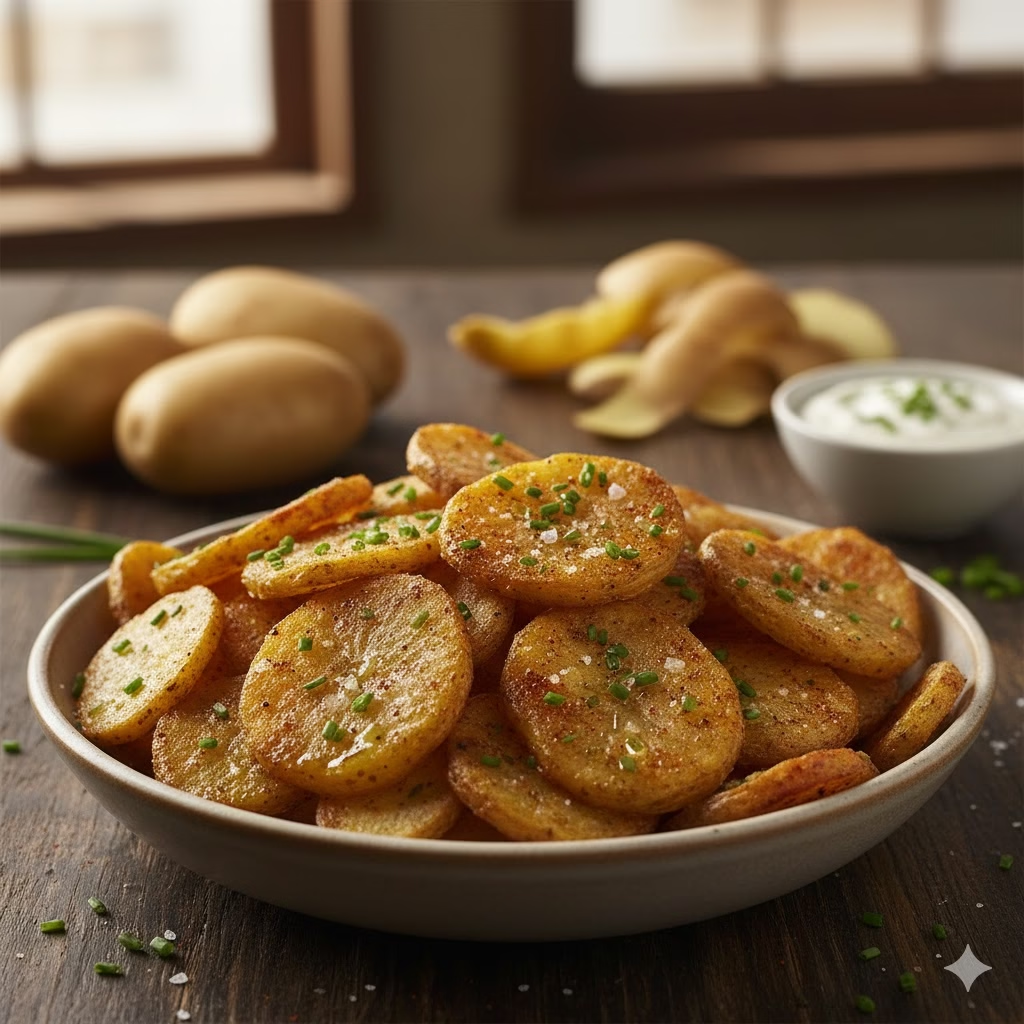
We all have those kitchen reflexes—like tossing a perfectly usable food item. This zero-waste journey began by recognizing that even something as humble as Potato Skins has incredible potential. Turning kitchen scraps into fantastic meals is not just rewarding; it’s fun! If you can transform a simple potato skin, you can transform your entire cooking mindset.
The Unexpected Hero: Unlocking the Power of Potato Skins
We’ve all been there: peeling potatoes for mash, salad, or a spectacular roast, and tossing those beautiful, earthy skins right into the compost or trash. It’s a kitchen reflex. But what if I told you that you are habitually discarding one of the most flavorful, versatile, and nutrient-dense parts of the potato? It’s true! The potato skin isn’t just a byproduct; it’s a hidden gem ripe for culinary transformation.
In our quest for efficiency and a commitment to reducing food waste—a goal that is both environmentally responsible and great for our wallets—repurposing kitchen scraps has become an essential skill. And few scraps offer the instant culinary payoff that potato skins do. Think about it: they’re pre-portioned, full of fiber, rich in vitamins, and, perhaps most importantly, incredibly textural. That thin layer of potato flesh still clinging to the skin, once roasted or fried, becomes pure, irresistible crunch.
This article isn’t just about reducing waste; it’s about instant gratification. We’re talking about ten incredibly easy and fast ways to turn those peelings into gourmet snacks, satisfying sides, and even innovative ingredients for other dishes. Forget complicated, time-consuming recipes. These are hacks you can implement right now, using ingredients you already have. Get ready to rethink your routine, maximize your potato prep, and elevate your cooking with these simple, powerful ideas for your leftover potato skins.
1. The Classic Crisps: Ultimate Homemade Potato Skin Chips

This is the cornerstone of potato skin utilization and often the first thing people think of, but the how-to makes all the difference between a sad, soggy peel and a shatteringly crisp chip. These are perfect for snacking or serving alongside a sandwich.
How to Do It:
- Prep: Wash the skins thoroughly before peeling. After peeling, pat them absolutely bone-dry with a clean kitchen towel or paper towels. Moisture is the enemy of crispiness.
- Season: Toss the skins in a bowl with a generous drizzle of olive oil, fine sea salt, and a pinch of your favorite seasoning (garlic powder and smoked paprika are excellent choices).
- Bake: Spread the skins in a single layer on a baking sheet. Overcrowding creates steam, leading to limp chips. Bake at 400∘F (200∘C) for 10 to 20 minutes, flipping halfway through.
- Finish: They are done when they are dark golden brown and audibly crisp. Serve immediately with a French onion dip or a simple vinegar drizzle.
2. Flavor-Packed Potato Skin Stock Base
Instead of using plain water or store-bought vegetable stock for your next soup or stew, use potato skins to create an inexpensive and deeply flavorful stock. The starches and residual flavor from the potato enrich the liquid beautifully.
How to Do It:
- Combine: Place a generous amount of potato skins into a large pot. Add rough-cut vegetable scraps you might also have, such as onion ends, carrot peels, and celery leaves.
- Simmer: Cover the ingredients with water, add a bay leaf and a few peppercorns. Bring to a boil, then reduce the heat and simmer gently for about an hour.
- Strain: Pour the liquid through a fine-mesh sieve or cheesecloth, pressing on the solids to extract all the liquid. Discard the spent skins and scraps.
- Use: The resulting golden liquid is a rich, slightly earthy stock, perfect for making gravy, adding depth to risotto, or serving as a base for a hearty vegetable soup.
3. Savory Baked “Bacon” Bits Substitute

For a vegetarian or vegan option, or simply when you want a quick, crispy topping for salads, baked potatoes, or mac and cheese, potato skins can mimic the crunch and savory notes of bacon bits.
How to Do It:
- Mix the Marinade: In a bowl, combine a teaspoon of olive oil with a drop of liquid smoke (optional, but adds a great smoky depth), a pinch of salt, a dash of garlic powder, and a small amount of nutritional yeast for a cheesy note.
- Coat: Toss the dried potato skins thoroughly in this mixture.
- Roast: Roast them at 375∘F (190∘C) until they are very dark and extremely crunchy, which usually takes around 20 minutes.
- Chop: Once cooled, chop them roughly into small pieces. Store them in an airtight container for a week of easy salad topping.
4. Garnish for Creamy Soups and Chili
A spoonful of richly seasoned, crispy potato skins can elevate a humble bowl of soup from ordinary to extraordinary. This works particularly well on creamy soups, like leek and potato, or hearty chilis where the crunchy texture contrasts nicely with the smooth base.
How to Do It:
- Follow the preparation steps for the Homemade Potato Skin Chips (Idea 1), ensuring they are extra crispy.
- Crush them lightly with your hands—you want small, irregular pieces, not dust.
- Sprinkle them over your finished chili or soup just before serving. The warmth will enhance their aroma.
5. Fried Potato Skin “Puffs” for Appetizers
When skins are peeled a bit thicker, they hold their shape better during a shallow fry, turning into delicious, airy puffs. This is a perfect, rustic appetizer for a casual dinner party.
How to Do It:
- Oil: Heat about a half-inch of neutral oil (like canola or vegetable oil) in a heavy-bottomed pan to medium-high heat.
- Fry: Carefully drop the dried, unseasoned skins into the hot oil. Do this in small batches to maintain oil temperature.
- Drain: Fry them for 2 to 3 minutes until golden and puffy. Remove with a slotted spoon and drain on paper towels.
- Season Immediately: While still hot, sprinkle them generously with a vibrant seasoning mix—try chili powder, lime zest, and cumin, or simply salt and pepper.
6. Homemade Potato Skin Salt Rub
Don’t just use salt on the skins; infuse your salt with the skins! Drying and blending the skins creates an earthy, umami-rich seasoning rub that enhances everything from roast chicken to scrambled eggs.
How to Do It:
- Dehydrate: Bake or dehydrate the skins (without oil or seasoning) until they are completely brittle. This may take up to an hour in a low-temp oven (200∘F or 95∘C).
- Blend: Place the brittle skins and a generous amount of coarse salt (like kosher or sea salt) into a food processor or a strong blender.
- Grind: Process until you have a fine, uniform seasoning blend.
- Store: Store this bespoke, earthy salt in a shaker to use as a finishing salt.
7. Potato Skin “Flour” for Thickening and Texture

The dehydrated skins can be pulverized even further than the salt rub to create a fine, earthy flour. This isn’t meant to replace wheat flour, but to act as a stealthy, flavorful thickener.
How to Do It:
- Pulverize: Follow the dehydration step from Idea 6, then grind the skins in a spice grinder until they are a very fine powder, avoiding any chunky pieces.
- Use: Stir a spoonful into stews, gravies, or sauces just before serving to add body, a rustic texture, and a subtle potato flavor boost. It’s a fantastic, low-carb alternative to traditional thickeners in certain dishes.
8. The Loaded Snack: Mini Potato Skin Bites

While traditional potato skins use the scooped-out potato itself, you can create a bite-sized, minimalist version using the skins alone, focusing on the topping. This is a speedy, crowd-pleasing snack.
How to Do It:
- Pre-Bake: Bake the skins (as in Idea 1) until they are about halfway cooked—still soft, but slightly firm.
- Top: Sprinkle the skins with shredded sharp cheddar cheese and small bacon pieces (or the vegetarian ‘bacon’ bits from Idea 3).
- Finish: Return them to the oven and bake until the cheese is melted, bubbly, and slightly browned.
- Garnish: Remove, let cool slightly, and top with a dollop of sour cream or Greek yogurt and a sprinkle of chopped chives. These disappear fast!
9. Rustic Bread Crumb Replacement in Meatloaf or Burgers
When making meatloaf, meatballs, or burgers, breadcrumbs are typically used as a binder and to keep the finished product moist.1 Finely chopped or ground potato skins can step in to serve this same purpose while adding an unbeatable rustic, savory depth.
How to Do It:
- Prep: Use a sharp knife to very finely mince the raw or slightly softened potato skins. Alternatively, pulse them a few times in a food processor—you don’t want a puree, just small pieces.
- Mix: Substitute the potato skin pieces for about a quarter of the breadcrumbs called for in your favorite recipe.
- Cook: Proceed with your usual recipe. The skins will essentially melt into the mixture as it cooks, lending moisture and flavor without changing the structural integrity of your meat dish.
10. Crispy, Savory Bowl Filler (Instead of Noodles)

Looking for a satisfying crunch in your next Asian-inspired rice or noodle bowl? Tossed with spices and baked until crisp, potato skins provide an exciting textural element that’s far more flavorful than plain croutons or fried noodles.
How to Do It:
- Season: Toss the dried potato skins with a teaspoon of sesame oil, a pinch of chili flakes, and a dash of soy sauce or tamari.
- Bake: Bake at 375∘F (190∘C) until very crispy.
- Garnish: Just before serving your ramen, pho, rice bowl, or stir-fry, sprinkle a handful of these savory skins over the top for a guaranteed textural pop.
Tips for Maximizing Your Potato Skin Yield
To ensure success with any of these methods, a little prep goes a long way.
- Wash Thoroughly: Potatoes grow in the soil, so a meticulous wash with a vegetable brush is critical before peeling. This is non-negotiable for cleanliness and flavor.
- The Thicker the Better: If you intend to make loaded bites or puffs, use a vegetable peeler that allows for a thicker peel, grabbing a little extra of the inner potato flesh. For chips and salts, a thin peel is just fine.
- Keep it Dry: When making crispy items (chips, garnishes), patting the skins completely dry before adding oil is the single most important step for achieving that signature crunch.
- Storage: Raw skins can be stored in the refrigerator in a sealed container for a few days, but they are best used immediately. Once baked, store them like potato chips—in an airtight container at room temperature.
By embracing these ten easy ideas, you’re not just saving scraps; you’re unlocking new possibilities in your kitchen. That feeling of turning what was once waste into a delicious, gourmet-style food is truly instant gratification.

Frequently Asked Questions (FAQ)
Q: Are potato skins actually nutritious?
A: Yes, they are! The skin holds a significant amount of the potato’s fiber, B vitamins, Vitamin C, and essential minerals like potassium and iron. When you eat the skin, you are getting more concentrated nutrition than if you only consumed the white, starchy interior.
Q: Do I need to use organic potatoes if I’m eating the skins?
A: While it is always recommended to choose organic when possible, the most important step is always to wash the potatoes thoroughly with a brush under running water to remove any dirt or surface residue. If you are concerned about pesticides, organic is the best choice.
Q: Can I use the skins from any type of potato?
A: Absolutely! Russet potato skins tend to be the thickest and most rugged, making them ideal for the loaded bites and classic chips. Yukon Gold and Red potato skins are thinner and more delicate, perfect for stock, salt rubs, or the savory bowl fillers where a light crisp is desired.
Q: How long can I store leftover baked potato skins?
A: Once they are fully baked and crispy, treat them like homemade potato chips. Store them in an airtight container at room temperature for up to four or five days. They can lose some crunch over time, so you might need a quick re-bake at 350∘F (175∘C) to refresh them.
References
- Everydayhealth – The Health Benefits of Potato Skins
- WebMD – Health Benefits of Potatoes
- Spudlite – The Importance of Potato Skins
Recent Posts


